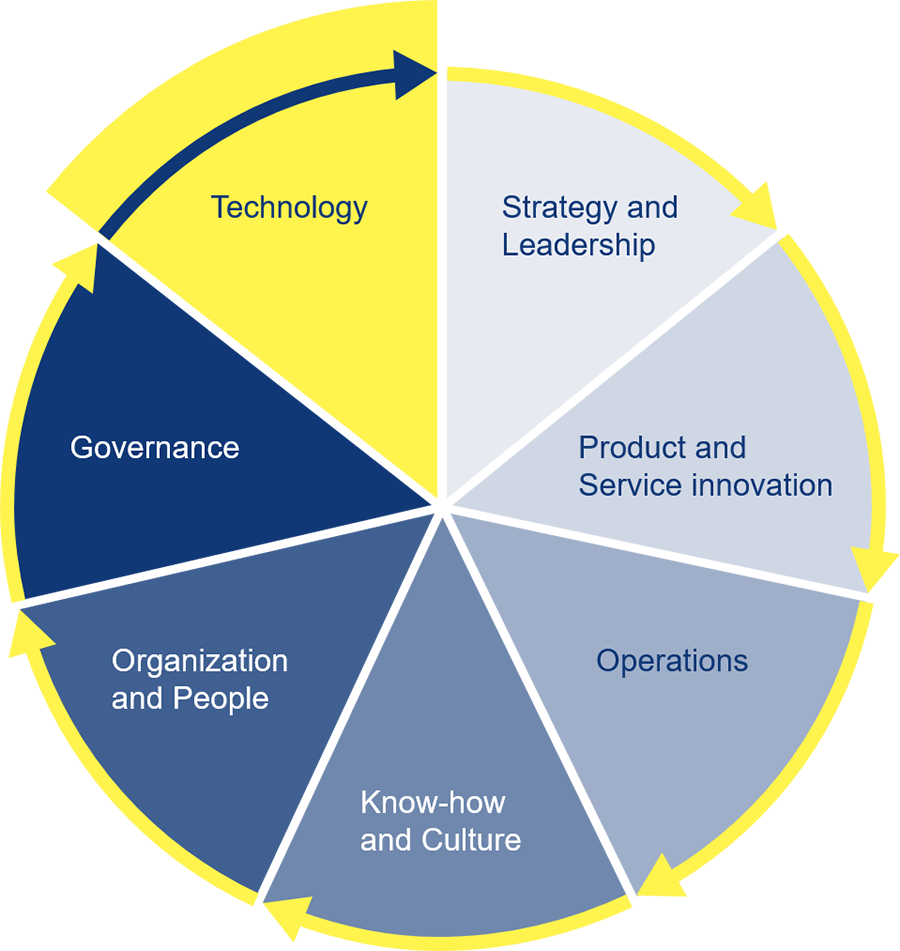Digitalization and the digital transformation are changing the environment for companies and especially the customer behavior fundamentally. The classical business models and business processes and interacting with the customer are being defined newly. Anyone who does not manage to disappears from the market.
The digital strategy includes all objectives and measures of the company to sustainably ensure the optimal business success. It is the goal of the digitalization strategy to increase the value creation and generate added value for the customer.
The digital transformation describes the implementation of the digitalization strategy. In this process of change all ways of thinking, processes, products, and business models are on trial and get adjusted if necessary.
FACTORS OF SUCCESS FOR A SUCCESSFUL DIGITAL TRANSFORMATION PROJECT ARE:

1. Strategy
In the beginning there is the digitalization strategy that uses the business strategy as its basis. Will there be new business models in the future? So far the digital transformation showed us that everything gets easier for the customer. In the background it can get much more complex. However, that is not visible to the customer. A second paradigm is that entire ecosystems develop and support each other. A prime example for this is Apple (iPhone, iTunes, Appstore, AppleWatch,…). The users gets provided with an easy life, changing the ecosystem would have consequences and the profit ends up in the provider’s cash register. The third paradigm is that the agent, the intermediary to the customer, requests a payment for this mediation. As a result, controlling the intersection to the customer plays a crucial role. Prime examples for this are Google and Amazon.
2. Leadership
For a successful digital transformation the commitment of every executive is necessary. This is best reflected in the personal agreement on objectives. Also enough resources need to be provided. Ideally these resources are provided dedicatedly.
3. Product & Service Innovation
Start interacting with your customers. Products and services get produced respectively provided for customers. Ask your customers for their needs and improvements. Integrate your customers into your marketing. Generally speaking, you should deal with the following questions:
- Which digital innovations are there in your business environment?
- Could they be turned into products or services that ease the life of the customer?
- Can several products respectively services be created complementing each other?
- Which things to start from?
And do start. Do start quickly. So many huge companies did not or too late realize the transformation and got flushed away by the wave of the digital transformation. Ride that wave instead and generate added values for your customers and thereby profit and growth for your business.
4. Operations
In the course of digitalization business models and operating models are changing. Due to innovation radical changes or even new forms may occur. Stakeholders as well as suppliers and customers can be integrated into the business processes. Thanks to direct feedback adjustments can take place very quickly.
5. Know-how & Culture
All participants in an organization need to be aware that the customer is the focus of attention. It is all about supporting the customer’s needs as best as possible and making the customer’s life easier. In the organization a climate has to be generated that allows for accepting the change and seeing and seizing the chances within the change. Typically a transformation from a hierarchical organization towards a collaborative, networked organization takes place. Part of that are also open, modern working places as well as the appropriate tools for collaborating. In order to overcome a department centered silo-thinking, also thinking in digital processes is helpful. For a general alignment of an organization it is recommended to anchor the goals of the digitalization in the agreement on objectives of both executives and employees. At the same time the employees should be granted certain degrees of freedom in order to develop an open, fault-tolerant, and agile culture .
6. Organization & People
The tasks, competences, and responsibilities needed in the course of digitalization have to be specified and documented in according roles. The required expertises then get called in externally or built up internally in the required strength by training offers.
7. Governance
Digital business is fast, agile, simple for the customer, but in terms of operations rather complex at times. This calls for governance by KPI’s just as fast. The different activities have to be coordinated, redundancies minimized, and complexities kept controllable. Creating measurability and controllability of these digital activities is the governance’s task.
8. Technology
The technological transformation is an essential driver of digitalization. Digital innovations shift market barriers and thus open up new possibilities. Technology supports them in that. For example various shopping channels are made possible in the first place by technology and the customers expect an overlapping shopping experience.
Digitalization can not be stopped. Either your company adjusts or it will go down. Freely adapted from Charles Darwin: “It is not the strongest of the species that survives, nor the most intelligent that survives. It is the one that is most adaptable to change.”
INTERESTING LINKS
Digital transformation of business / society: Futurist Gerd Leonhard at Orange Business Hello World
https://www.youtube.com/watch?v=woLqFNIugVg
FEEDBACK
If you have any questions or suggestions please write to me under the heading of “digital transformation”:
michael.muthig@mutcon.com
I am looking forward to your contacting!